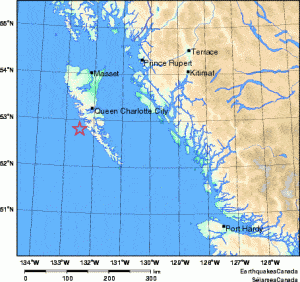

According to catastrophe modeling firm AIR Worldwide, a powerful 7.7 magnitude earthquake struck off British Columbia’s north-central coast, shaking regions as far away as Edmonton and Yukon.

According to the United States Geological Survey, the earthquake, which struck at a depth of 17.5 kilometers, occurred at 8:04 p.m. local time (03:04 UTC) 139 km south of Masset, British Columbia. At least 10 aftershocks have been recorded, the largest of which was 6.3. Given that the yesterday’s earthquake occurred in a sparsely populated stretch of the Canadian coast, significant insured losses are not expected.
According to AIR, the quake also triggered tsunami warnings from the Washington border to Vancouver Island and as far away as Hawaii. At least 100,000 fled to higher ground along Hawaii’s coast late on Saturday but the evacuation order was later cancelled. A wave of five feet has been recorded near Maui.
Buildings near the epicenter shook for about forty seconds, but little damage has been reported in this sparsely populated region. Ground shaking caused power disruptions and toppled residential contents—televisions, dishes and the like.
According to AIR, the epicentral location of today’s earthquake is along the Queen Charlotte fault. The Queen Charlotte and Fairweather Faults are part of a fault system that marks the eastern boundary of the Pacific plate and the western boundary of the North American plate. The Pacific plate moves in a northwestward direction relative to the North American plate, creating a transform boundary—the name of two plates that move horizontally in opposite directions. The fault associated with a transform boundary is a strike-slip fault. The Queen Charlotte and Fairweather faults are very similar to some of the most well-known strike-slip faults in the world, including California’s San Andreas Fault system.
A number of major earthquakes have been linked to the Queen Charlotte-Fairweather fault system in the last century. A segment of the Queen Charlotte fault—northwest of the present earthquake—ruptured in 1949 causing an 8.1 right‐lateral strike‐slip earthquake (the epicenter was located 160 km northwest of today’s earthquake). In 1970, a segment of the fault, southeast of today’s earthquake, ruptured with a 7.5 earthquake (the epicenter was 130 km southeast of today’s earthquake).
Source: AIR Worldwide